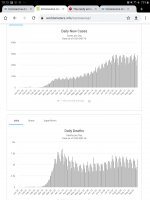elbows
Well-Known Member
I will use this thread when the amount of detail involved is a bit much for the main conversational threads, although if people want to have conversations about the detail in this thread too then I wont see anything wrong with that.
Here is a very large document from mid July on the Direct and indirect impact of Covid-19 on excess deaths and morbidity, and most of the numbers are for England only. It covers a large number of themes in much detail, as well as using an unrealistic modelling scenario where number of deaths after the first peak remains rather static till next March (so there is no real second wave in their resulting figures). I cannot hope to cover everything and will instead start by zooming in on one area in particular.
Also note that QALY = Quality Adjusted Life Years. One QALY equates to one year lived in perfect health.
Anyway, on with the cherry picking....



Look at the decrease in years of life lost due to air pollution reductions in lockdown!
Although note that those estimates are not the only ones offered, so I have placed the alternative optimistic and pessimistic versions of that table in spoiler tags below.
Source: https://assets.publishing.service.g...-covid-19-excess-deaths-morbidity-sage-48.pdf
Via: SAGE meetings, July 2020
Here is a very large document from mid July on the Direct and indirect impact of Covid-19 on excess deaths and morbidity, and most of the numbers are for England only. It covers a large number of themes in much detail, as well as using an unrealistic modelling scenario where number of deaths after the first peak remains rather static till next March (so there is no real second wave in their resulting figures). I cannot hope to cover everything and will instead start by zooming in on one area in particular.
Also note that QALY = Quality Adjusted Life Years. One QALY equates to one year lived in perfect health.
Anyway, on with the cherry picking....


D2: Impacts of a lockdown-induced recession
Short-term impacts
The short-term mortality impacts of the lockdown-induced recession are estimated to be 4,500 fewer excess deaths (equivalent to 30,000 gained QALYs) occurring within a year of the lockdown; these are expected to come from an estimated reduction in the number of fatalities due to a reduction in cardiovascular diseases, dementias and respiratory diseases. We assume here that mortality is procyclical – i.e. that a deteriorating economic situation is associated with short-term reductions in mortality rates. Studies have found higher mortality rates during economic booms and lower mortality rates during recessions, with the relationship holding true for previous economic downturns.
The short-term morbidity impacts of the lockdown-induced recession are estimated to equate to 17,000 gained QALYs; they are expected to come from an estimated increase in mental health problems, counterbalanced by a reduction in unintentional injuries (mostly occupational injuries), reduction in chronic respiratory diseases, and reduction in transport injuries.
Medium and long-term impacts
We estimate an increase of 18,000 excess deaths as a result of the medium-term mortality impacts of the lockdown-induced recession, occurring 2-5 years following the lockdown, equivalent to 157,000 lost QALYs; the main impacts are expected to come from an estimated increase in the number of fatalities due to increased cardiovascular diseases. We estimate the medium-term morbidity impacts of the lockdown-induced recession to equate to 438,000 lost QALYs; the main impacts are expected to come from an estimated increase in musculoskeletal disorders and mental health problems.
We estimate the long-term mortality impact of the lockdown-induced recession (more than 5 years in the future) using two different approaches. In the first approach, we use the Office for National Statistics’ (ONS) life tables to estimate the impacts on those who were aged 15-24 during the lockdown-induced recession. We assume a -0.3 GDP-to-mortality elasticity. This estimates 15,000 excess deaths, equivalent to 294,000 lost QALYs; this is from a slightly elevated all-cause mortality impact for younger people who would enter the labour market a few years before, during, and a within a few years after the recession.
It is important to note that the robustness of the medium and long-term impacts of a lockdown induced recession is low as estimates are based on academic literature on previous recessions. The profile of past recessions will be different to a lockdown induced recession, and should be considered when reviewing the estimates.
For the other approach, we use the Index of Multiple Deprivation for England (IMD) and assume a - 1.0 GDP-to-IMD score elasticity per year giving an estimate of 17,000 additional deaths per year for every year that GDP remains at a low level. The timing of when these excess deaths would occur is not specified but they are likely to be long-term.

Look at the decrease in years of life lost due to air pollution reductions in lockdown!
Although note that those estimates are not the only ones offered, so I have placed the alternative optimistic and pessimistic versions of that table in spoiler tags below.
Source: https://assets.publishing.service.g...-covid-19-excess-deaths-morbidity-sage-48.pdf
Via: SAGE meetings, July 2020

























